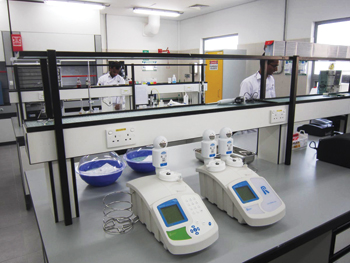Apollo secures major Bahrain STP
01 March 2015
Apollo Fire Detectors has provided hundreds of fire-detection and fire-fighting systems to Samsung Engineering for its Muharraq sewage treatment plant.
Following the recent completion of a major sewage treatment plant in Bahrain which utilised its analogue addressable XP95 range, Apollo Fire Detectors looks forward to exciting prospects in the region where it intends to launch a range of new products.
The UK-based manufacturer of fire detection solutions for commercial and industrial applications joined hands with its local partner Khayber Trading to provide an effective fire detection system for the multi-million-dollar Muharraq sewage treatment plant (STP) in Bahrain, which was completed late last year.
The challenge was to protect the new STP, which has a treatment capacity of 100,000 cu m per day, with the associated risks of flammable gases and hazardous emissions, says a spokesman for Apollo.
Khayber Trading, which has represented Apollo Fire Detectors in the region for many years, was awarded the contract to supply, install, test, and maintain the fire-detection and fire-fighting systems by Samsung Engineering.
C V Sathish Babu, sales manager at Khayber Trading, says: “We’ve been installing Apollo products for over 20 years, and choose them because of their competitive pricing, reliability, durability, user-friendliness and availability of products. The total fire-detection and suppression system used at the Muharraq STP provides excellent protection for its staff, visitors and property with a system which is designed to the National Fire Protection Association (NFPA) 820 standard for fire protection in wastewater treatment and collection facilities.”
The spokesman says the fire detection system at the Muharraq STP consists solely of products from Apollo’s analogue addressable XP95 range. The installation include more than 300 multi-sensor detectors, over 100 intelligent sounders, 26 sounders/visual indicators and over 90 manual call points (MCPs) networked across 59 zones via an Elite four-loop fire alarm panel and repeater.
He explains: “The fire alarm system interfaces with a number of systems on site in the event of an activation, for example, to shut down the heating, ventilation and air-conditioning (HVAC) system and to control air-conditioning dampers.”
The system is also interconnected with fire extinguishing control panels which control the release of FM-200 and carbon dioxide (CO2) gas extinguishing systems. All the systems are interfaced with the site Scada (supervisory control and data acquisition) system for reporting alarms and faults, he adds.
Additional intrinsically safe (IS) devices from the XP95 range were specified for the laboratory areas in the plant to minimise the ignition risk from potentially flammable gases and vapours. “Apollo’s IS equipment operates at such low power and with such small amounts of stored energy that it is incapable of causing ignition, not only in normal operation but also in fault conditions,” says the spokesman.
 |
|
An XP95 detector. |
The fire alarm network is programmed at each of the 59 zones, with each building separated into different sub-zones and a common alarm installed in each building. Once the system is activated, both sounders inside and sounder strobes outside, alert occupants. To provide additional support, the Muharraq STP also incorporates MCPs for manual activation.
The $325-million Muharraq STP project, located on reclaimed land, is overseen by the Muharraq STP Company under a 27-year build, own, operate and transfer (boot) scheme – the first of its kind in the country.
The site currently covers an area of about 157,000 sq m and its two-storey facilities can accommodate by 50 to 80 staff and visitors at any one time. It is designed to have a lifespan of 25 years and has a provision for future expansion to treat 160,000 sq m per day.
The STP includes a deep gravity sewer (DGS) which is connected to 24 pump stations. Once waste reaches the DGS via new network connections, it is further discharged to a new terminal lifting station at the head of the new STP before being processed.
Also included in the project build was the construction of a new incinerator plant to treat the sludge from the sewage treatment plant, which will be used as fertiliser.
The Muharraq STP has also won the Middle East Water/PPP Deal of the Year 2011 awarded by Project Finance magazine.
Commenting on the market and Apollo’s plans for the region, Matt Pay, international sales development manager at Apollo Fire Detectors, says: “The Middle East market continues to be an attractive location for Apollo. It is fast paced, exciting and continues to offer diverse and interesting projects such as the Muharraq STP. 2015 is an exciting year for Apollo, with a planned launch of new products that will be ideal for the expanding Middle Eastern area.”
Apollo continues to secure some of the landmark projects globally, its latest successes including the St Bartholomew’s Hospital (commonly known at Barts), a leading, internationally-renowned teaching hospital based in London, UK. The new fire detection system installation followed two phases of both new build and refurbishment works at Barts. In total, more than 6,500 Apollo Discovery units are installed throughout the facility, including over 5,000 multi-sensor detectors and 1,000 MCPs. The fire alarm control system consists of 28 networked Series 900 Evo panels.
- Apollo secures major Bahrain STP
- Dorma sheds light on fire safety codes
- Tremco to market Nullifire in region



